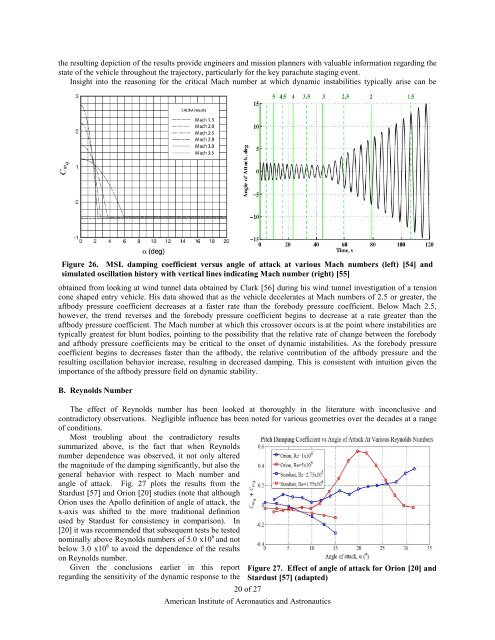Survey of Blunt Body Dynamic Stability in Supersonic Flow
Survey of Blunt Body Dynamic Stability in Supersonic Flow
Survey of Blunt Body Dynamic Stability in Supersonic Flow
You also want an ePaper? Increase the reach of your titles
YUMPU automatically turns print PDFs into web optimized ePapers that Google loves.
the result<strong>in</strong>g depiction <strong>of</strong> the results provide eng<strong>in</strong>eers and mission planners with valuable <strong>in</strong>formation regard<strong>in</strong>g the<br />
state <strong>of</strong> the vehicle throughout the trajectory, particularly for the key parachute stag<strong>in</strong>g event.<br />
Insight <strong>in</strong>to the reason<strong>in</strong>g for the critical Mach number at which dynamic <strong>in</strong>stabilities typically arise can be<br />
Figure 26. MSL damp<strong>in</strong>g coefficient versus angle <strong>of</strong> attack at various Mach numbers (left) [54] and<br />
simulated oscillation history with vertical l<strong>in</strong>es <strong>in</strong>dicat<strong>in</strong>g Mach number (right) [55]<br />
obta<strong>in</strong>ed from look<strong>in</strong>g at w<strong>in</strong>d tunnel data obta<strong>in</strong>ed by Clark [56] dur<strong>in</strong>g his w<strong>in</strong>d tunnel <strong>in</strong>vestigation <strong>of</strong> a tension<br />
cone shaped entry vehicle. His data showed that as the vehicle decelerates at Mach numbers <strong>of</strong> 2.5 or greater, the<br />
aftbody pressure coefficient decreases at a faster rate than the forebody pressure coefficient. Below Mach 2.5,<br />
however, the trend reverses and the forebody pressure coefficient beg<strong>in</strong>s to decrease at a rate greater than the<br />
aftbody pressure coefficient. The Mach number at which this crossover occurs is at the po<strong>in</strong>t where <strong>in</strong>stabilities are<br />
typically greatest for blunt bodies, po<strong>in</strong>t<strong>in</strong>g to the possibility that the relative rate <strong>of</strong> change between the forebody<br />
and aftbody pressure coefficients may be critical to the onset <strong>of</strong> dynamic <strong>in</strong>stabilities. As the forebody pressure<br />
coefficient beg<strong>in</strong>s to decreases faster than the aftbody, the relative contribution <strong>of</strong> the aftbody pressure and the<br />
result<strong>in</strong>g oscillation behavior <strong>in</strong>crease, result<strong>in</strong>g <strong>in</strong> decreased damp<strong>in</strong>g. This is consistent with <strong>in</strong>tuition given the<br />
importance <strong>of</strong> the aftbody pressure field on dynamic stability.<br />
B. Reynolds Number<br />
The effect <strong>of</strong> Reynolds number has been looked at thoroughly <strong>in</strong> the literature with <strong>in</strong>conclusive and<br />
contradictory observations. Negligible <strong>in</strong>fluence has been noted for various geometries over the decades at a range<br />
<strong>of</strong> conditions.<br />
Most troubl<strong>in</strong>g about the contradictory results<br />
summarized above, is the fact that when Reynolds<br />
number dependence was observed, it not only altered<br />
the magnitude <strong>of</strong> the damp<strong>in</strong>g significantly, but also the<br />
general behavior with respect to Mach number and<br />
angle <strong>of</strong> attack. Fig. 27 plots the results from the<br />
Stardust [57] and Orion [20] studies (note that although<br />
Orion uses the Apollo def<strong>in</strong>ition <strong>of</strong> angle <strong>of</strong> attack, the<br />
x-axis was shifted to the more traditional def<strong>in</strong>ition<br />
used by Stardust for consistency <strong>in</strong> comparison). In<br />
[20] it was recommended that subsequent tests be tested<br />
nom<strong>in</strong>ally above Reynolds numbers <strong>of</strong> 5.0 x10 6 and not<br />
below 3.0 x10 6 to avoid the dependence <strong>of</strong> the results<br />
on Reynolds number.<br />
Given the conclusions earlier <strong>in</strong> this report<br />
regard<strong>in</strong>g the sensitivity <strong>of</strong> the dynamic response to the<br />
Figure 27. Effect <strong>of</strong> angle <strong>of</strong> attack for Orion [20] and<br />
Stardust [57] (adapted)<br />
20 <strong>of</strong> 27<br />
American Institute <strong>of</strong> Aeronautics and Astronautics
















